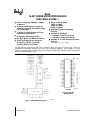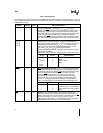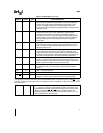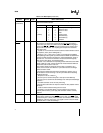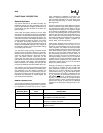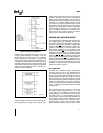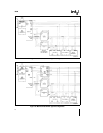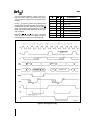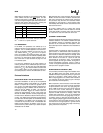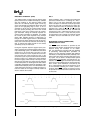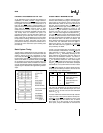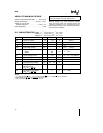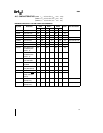
8086
FUNCTIONAL DESCRIPTION
General Operation
The internal functions of the 8086 processor are
partitioned logically into two processing units The
first is the Bus Interface Unit (BIU) and the second is
the Execution Unit (EU) as shown in the block dia-
gram of Figure 1
These units can interact directly but for the most
part perform as separate asynchronous operational
processors The bus interface unit provides the func-
tions related to instruction fetching and queuing op-
erand fetch and store and address relocation This
unit also provides the basic bus control The overlap
of instruction pre-fetching provided by this unit
serves to increase processor performance through
improved bus bandwidth utilization Up to 6 bytes of
the instruction stream can be queued while waiting
for decoding and execution
The instruction stream queuing mechanism allows
the BIU to keep the memory utilized very efficiently
Whenever there is space for at least 2 bytes in the
queue the BIU will attempt a word fetch memory
cycle This greatly reduces ‘‘dead time’’ on the
memory bus The queue acts as a First-In-First-Out
(FIFO) buffer from which the EU extracts instruction
bytes as required If the queue is empty (following a
branch instruction for example) the first byte into
the queue immediately becomes available to the EU
The execution unit receives pre-fetched instructions
from the BIU queue and provides un-relocated oper-
and addresses to the BIU Memory operands are
passed through the BIU for processing by the EU
which passes results to the BIU for storage See the
Instruction Set description for further register set
and architectural descriptions
MEMORY ORGANIZATION
The processor provides a 20-bit address to memory
which locates the byte being referenced The memo-
ry is organized as a linear array of up to 1 million
bytes addressed as 00000(H) to FFFFF(H) The
memory is logically divided into code data extra
data and stack segments of up to 64K bytes each
with each segment falling on 16-byte boundaries
(See Figure 3a)
All memory references are made relative to base ad-
dresses contained in high speed segment registers
The segment types were chosen based on the ad-
dressing needs of programs The segment register
to be selected is automatically chosen according to
the rules of the following table All information in one
segment type share the same logical attributes (eg
code or data) By structuring memory into relocat-
able areas of similar characteristics and by automati-
cally selecting segment registers programs are
shorter faster and more structured
Word (16-bit) operands can be located on even or
odd address boundaries and are thus not con-
strained to even boundaries as is the case in many
16-bit computers For address and data operands
the least significant byte of the word is stored in the
lower valued address location and the most signifi-
cant byte in the next higher address location The
BIU automatically performs the proper number of
memory accesses one if the word operand is on an
even byte boundary and two if it is on an odd byte
boundary Except for the performance penalty this
double access is transparent to the software This
performance penalty does not occur for instruction
fetches only word operands
Physically the memory is organized as a high bank
(D
15
–D
8
) and a low bank (D
7
–D
0
) of 512K 8-bit
bytes addressed in parallel by the processor’s ad-
dress lines A
19
–A
1
Byte data with even addresses
is transferred on the D
7
–D
0
bus lines while odd ad-
dressed byte data (A
0
HIGH) is transferred on the
D
15
–D
8
bus lines The processor provides two en-
able signals BHE
and A
0
to selectively allow read-
ing from or writing into either an odd byte location
even byte location or both The instruction stream is
fetched from memory as words and is addressed
internally by the processor to the byte level as nec-
essary
Memory Segment Register Segment
Reference Need Used Selection Rule
Instructions CODE(CS) Automatic with all instruction prefetch
Stack STACK (SS) All stack pushes and pops Memory references relative to BP
base register except data references
Local Data DATA(DS) Datareferences when relative to stack destination of string
operation or explicitly overridden
External (Global) Data EXTRA (ES) Destination of string operations explicitly selected using a
segment override
6



